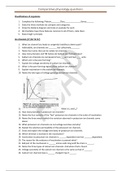Exam (elaborations)
Comparative Physiology Questions (150 )
- Course
- Institution
- Book
These notes would be ideal for an undergraduate student in biological sciences, specifically but not limited to physiology. The questions are divided into 11 different lectures. The mark scheme will also be made available in www.stuvia.co.uk and search for Comparative physiology Answers. This would...
[Show more]




